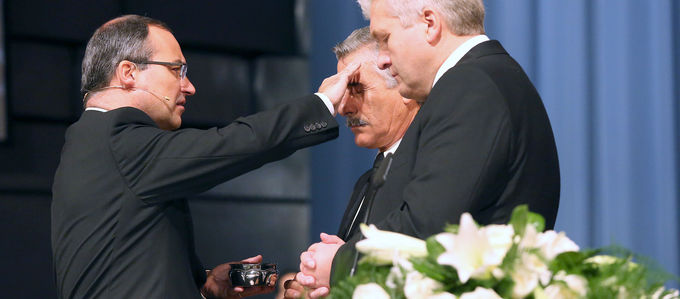
Sacraments — what is required for these? Wouldn’t faith be sufficient all on its own? The answer to this comes from Jesus Christ Himself. But how do they actually function, these doors that bring us close to God?
A smile darts across the face. This is first of all a sign of joy, but at the same time it is far more than merely a symbolic action. After all, the smile expresses joy and even makes this joy tangible and perceptible. It is similar with the sacraments—only that there is a lot more than that to the story.
This is because sacraments are necessary in order to attain salvation in Jesus Christ. This is something the Son of God Himself made clear: anyone who is not born again out of water and the Spirit cannot enter into the kingdom of God (John 3: 3-5). And only those who eat His body and blood will have eternal life (John 6: 54).
God acts for salvation
“Sacraments are fundamental acts of God’s grace,” explains the Catechism of the New Apostolic Church (CNAC, chapter 8). “They are holy acts that are performed upon a human being in order to allow him to attain salvation.” So it is that God grants His nearness through baptism, and allows human beings to share in His substance in Holy Communion. Receiving all the sacraments opens the way for believers to be united with the Lord at Christ’s return.
Every sacrament is rooted in the words and activity of Jesus Christ as well as in the sending of the Holy Spirit. It is for this reason that theologians also speak of the Son of God as the “Primordial sacrament” and of the church established by Him as the “fundamental sacrament”.
The invisible revealed
All sacraments follow a common blueprint comprised of four cornerstones which are known as sign, content, dispenser, and faith:
- the sign is the visible element or action, for example, the water in Holy Baptism or the laying on of hands in Holy Sealing.
- the content is the presence of salvation, that is to say, the washing away of original sin, the establishment of a close relationship with God, and incorporation into the church of Christ in Holy Baptism, for example.
- the dispenser is the commissioned minister who serves as mediator.
- the faith of the recipient is required in order for the sacrament to be received for salvation.
Here the sacraments—very much like the church of Christ—reflect the dual nature of Jesus Christ. The visible sign, which is the human side, and the invisible content, which is the divine side, are bound together in the words of institution. This becomes most apparent in Holy Communion: the visible elements are bread and wine in the form of a wafer. Through the words of consecration, the invisible substance of the body and blood of Christ are joined to these. A entity comes into being. Jesus is truly present.
Effect requires faith
“The validity of the sacraments is not dependent on their interpretation or the understanding a person has of them, but rather only on the four aforementioned variables,” emphasises the CNAC. Not even unbelief can invalidate the sacrament, “because that which God has done cannot be undone by the unbelieving recipient.
However, sacraments are not some quasi-magical ritual that take their effect automatically. The faith of the person receiving them is the prerequisite for the sacrament to unfold to its full effect for salvation. It becomes active for blessing from the very moment the recipient comes to faith.
Sacraments are not an invention of the New Apostolic Church. The doctrine of the sacraments looks back on over 2,000 years of Christian history and has many interdenominational commonalities. Mind you, the term does not appear in this form in the Bible—but more on that in the next issue of this series
Photo: megaflopp – stock.adobe.com














